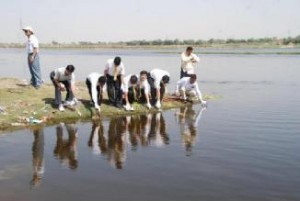Success Stories and Case Studies
Baba Amte Centre For People's Empowerment: case study of a support voluntary organisation
Posted on 01 May, 2009 01:27 PMDilemma facing NGO action
Watershed development is not merely a matter of harvesting rainwater. Its success crucially entails:
• working out collective protocols of equitable and sustainable use of surface and ground water
Water to the people: drinking water and water for livelihoods - conflicts and alternative concepts in India – A report by Centre for World Solidarity (CWS) and Church Development Service (EED)
Posted on 30 Apr, 2009 12:21 PMThis study is a part of water and democracy programme initiated by the Centre for World Solidarity (CWS) as a joint initiative with Church Development Service (EED) in 2007 involving more than 50 partner organisations in South Asia.
Water democracy - reclaiming public water in Asia: collection of essays by reclaiming public water (RPW) network
Posted on 29 Apr, 2009 05:08 PMThe collection includes the following four case studies from India:
Agra: Yamuna river trash cleanup 2009
Posted on 23 Apr, 2009 11:45 AMAhead of the Lok Sabha polls, hundreds of students of several schools along with senior citizens cleaned up Poiya Ghat Sunday morning, picking up rags and used polythene bags, to focus attention on river pollution which candidates of various political parties have chosen to ignore.
Brij Khandelwal, programme convener of the Yamuna Foundation and Rivers of the World Foundation, said apart from students involved in the My Clean Agra initiative, a large number of other voluntary groups and organisations were involved in Sunday's programme which specifically targeted the politicians for failing to clean up the cities and the rivers of India.
"No political party has bothered to say a word about how they would save a dying river and rejuvenate it or restore its original glory," said Subhash Jha and Haridutt Sharma of the Yamuna Foundation for Blue Water.
New knowledge resources: Nitrates & cancer
Posted on 19 Apr, 2009 02:02 PM  Nitrate/Nitrite contamination is a potentially serious problem for India today, after flouride and arsenic. This contamination occurs largely through the mixing of fertiliser run-off and sewage with water meant for human use. New research reveals that Nitrate/Nitrite contamination can cause severe human health problems including cancer. Below are two research papers from the Environment Health Perspectives (EHP) Journal, written in the context of the United States, that give an idea of Nitrate/Nitrite contamination and their impact on human health. Workgroup Report in the November 2005 issue: "Drinking Water Nitrate and Health - Recent Findings and Research Needs". Read the paper here: https://www.indiawaterportal.org/tt/dwm/res/Drinking_Water_Nitrate_and_Health_Nov%202005_EHP.pdf "A Review of Nitrates in Drinking Water: Maternal Exposure and Adverse Contents Reproductive and Developmental Outcomes", appeared in the March 2006 issue. Read the paper here: https://www.indiawaterportal.org/tt/dwm/res/A_Review_of_Nitrates_in_Drinking_Water_Mar_2006_EHP.pdf
Nitrate/Nitrite contamination is a potentially serious problem for India today, after flouride and arsenic. This contamination occurs largely through the mixing of fertiliser run-off and sewage with water meant for human use. New research reveals that Nitrate/Nitrite contamination can cause severe human health problems including cancer. Below are two research papers from the Environment Health Perspectives (EHP) Journal, written in the context of the United States, that give an idea of Nitrate/Nitrite contamination and their impact on human health. Workgroup Report in the November 2005 issue: "Drinking Water Nitrate and Health - Recent Findings and Research Needs". Read the paper here: https://www.indiawaterportal.org/tt/dwm/res/Drinking_Water_Nitrate_and_Health_Nov%202005_EHP.pdf "A Review of Nitrates in Drinking Water: Maternal Exposure and Adverse Contents Reproductive and Developmental Outcomes", appeared in the March 2006 issue. Read the paper here: https://www.indiawaterportal.org/tt/dwm/res/A_Review_of_Nitrates_in_Drinking_Water_Mar_2006_EHP.pdf
Veera Narayana temple at Gadag town, Karnataka, solves its drinking water problem in summer by harvesting rainwater of 2005 monsoon
Posted on 16 Apr, 2009 01:17 PM"Going home with more than theerth", is a case study written by Shree Padre in April 2007, on the how the problem of drinking water availability in summer, was solved by the Veera Narayana Temple at Gadag town, through rain water harvesting.
District panchayat office in Kasaragod, Kerala, uses rainwater harvesting to tap the overhead source: a case study
Posted on 16 Apr, 2009 01:07 PM"Plenty on the roof", is a case study written by Shree Padre in August 2005, of how a district panchayat office in Kerala, used rainwater harvesting not just to overcome shortages in piped supply, but to tap the overhead source, so that no other source was needed.
Ph.D in Ecological Sanitation by a student at the University of Agricultural Sciences, Bangalore
Posted on 16 Apr, 2009 11:21 AMRecharge of deep borewells in hard rock terrain
Posted on 14 Apr, 2009 11:11 AMIndia's dependence on the underground aquifer especially deep bore wells are well known. With over 22 million wells India has perhaps one of the largest such structures in the world. Since most of peninsular India is hard rock with basalt/granite/gneiss underlying they present a particular challenge for understanding.
